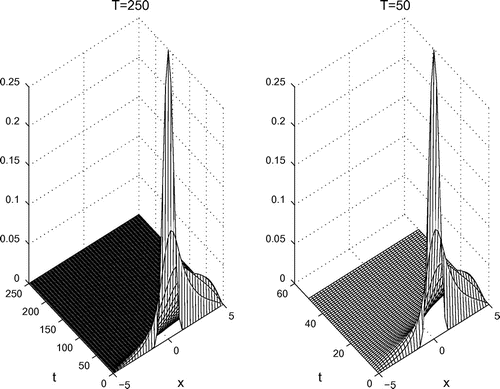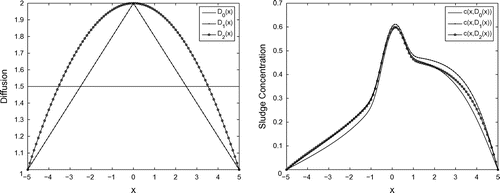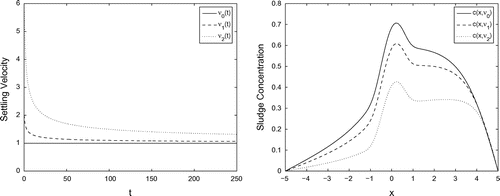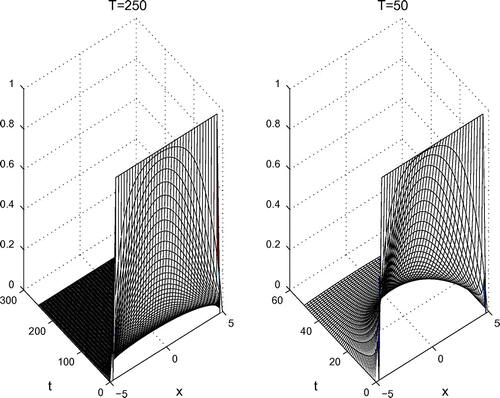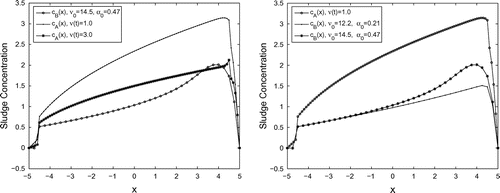 ?Mathematical formulae have been encoded as MathML and are displayed in this HTML version using MathJax in order to improve their display. Uncheck the box to turn MathJax off. This feature requires Javascript. Click on a formula to zoom.
?Mathematical formulae have been encoded as MathML and are displayed in this HTML version using MathJax in order to improve their display. Uncheck the box to turn MathJax off. This feature requires Javascript. Click on a formula to zoom.Abstract
Identification problems related to age dependent models of a settling process in the secondary settler of a wastewater treatment plant are considered. The basic model is governed by the nonlinear parabolic equation describing the scalar conservation law for the density of sludge mass, and by a nonlocal (integral form) additional condition. The problem is formulated as an identification problem, where the sludge concentration
is assumed to be a control. The mathematical analysis, based on the weak solution theory of PDEs, of the basic model shows the degree of sensitivity of the solution
of the parabolic equation with respect to the coefficient
. The results obtained here are then applied to two widely accepted settling velocity models (
and
). An effective iteration algorithm for numerical solution of identification problems related to these models is proposed. The algorithm is tested for the both settling velocity models. Computational simulation permits one to show an influence of the settling velocity models to the behavior of the sludge concentration
.
1 Introduction
The paper deals with the estimation of the sludge concentration in the secondary settler, which is designed to substantially degrade the biological content of the sewage which are derived from human waste, food waste, soaps and detergent, etc. of a wastewater treatment plant. Figure shows a generalized schematic outline of an wastewater treatment process in the plant. Most engineering literature is devoted to pure experimental studies, with analysis of various data measured for concrete settling process or real plant.[Citation1] Notwithstanding the importance of these experimental studies, during last decades the number of theoretical studies related to settling process in a wastewater treatment increases. Thus, an analytical model using partial differential equations expressing the sludge mass conservation is proposed in [Citation2]. A layered cylindrical settler model, expressing the sludge mass conservation and allowing to calculate the sludge concentration in each layer from one time step to another one, is studied by [Citation3, Citation4]. Depending on the nature and concentration of solid particles, classification of various settling characteristics in wastewater treatment plant are presented in [Citation4]. Most of subsequent settling models are still using this classification. Another kind of mathematical models are based on more general approach, and can be used for general settler. These kinds of mathematical models are proposed in [Citation5], and then developed in [Citation6–Citation8]. The mathematical model proposed here can be considered as an extension of the model given in [Citation9]. Specifically, we study the following transport-diffusion identification model of a settler, with nonlocal condition:1
1 Here the density of sludge particles having spent time
in a settler at point
is defined by the function
. The function
denotes the sludge concentration at point
. This model assumes that the mass transport is due to not only advection, but also diffusion
. The settling mechanism is modeled by the function
, which usually includes the water velocity, and settling velocity. The later depends on the sludge concentration
also. In the simplest case, when
, and the maximum settling velocity
is a constant, the above transport-diffusion model has been considered in [Citation10]. It is shown here that in this case the PDE model can be reduced to a nonlinear ODE model. When
2
2 and the settling velocity
depends on time, another kind of mathematical models arise in convective-diffusive fluid problems.[Citation11] In subsequent, we will define this model, governed by Equations (Equation1
1
1 ) and (Equation2
2
2 ), as the Model A.
One of the most widely accepted settling velocity model is proposed in [Citation12]:3
3 where
is the maximum settling velocity, and
is the model parameter. This settling velocity model has successfully been used in [Citation4, Citation13, Citation14]. We will define this model which uses the Vesilind model of settling mechanism, as the Model B. This model is governed by Equations (Equation1
1
1 ) and (Equation3
3
3 ).
Besides of the above cited studies, various mathematical models related to the convection-diffusion equation have been considered in [Citation15–Citation18]. Some of these mathematical models also lead to inverse/identification problems with local or nonlocal additional conditions (see [Citation15] and references therein). Note that when the coefficient is known, the first two equations in (1) define the linear direct problem. However, when the
is unknown and needs to be defined from the last integral condition in (1), then the identification problem (1) is nonlinear.
This study is motivated by computer simulation of the secondary settling process based on the above mathematical models. Our goal is to estimate an influence of existing settling velocity models/parameters to the behavior of the sludge concentration function .
The paper is organized as follows. The sensitivity analysis of the solution of the parabolic problem with respect to the coefficient
is discussed in Section 2. Iteration algorithm and numerical results for the Model A and Model B, are given in Sections 3 and 4, respectively. In Section 5 a computational comparative analysis of both models is presented. This analysis shows similarity as well as differences of two models, also permits one to estimate an influence of Vesilind parameters to the behavior of the sludge concentration coefficient
.
2 Sensitivity analysis of the solution 
 with respect to the coefficient
with respect to the coefficient 

We suppose that , and
in (1) and consider the parabolic problem
4
4 where
. We assume that the variable
belongs to the one dimensional compact space
,
is large enough, and
denotes the final time and simulates the infinity. Although the homogeneous boundary conditions
may not be realistic for all physical models, we assume here that in the considered case the density of sludge particles on the boundary is small enough.
This problem can be treated as a basic problem for both considered above models. It can be obtained by substitution the additional integral condition in (1) into the parabolic equation. The positive functions ,
,
,
and
satisfy the following conditions:
5
5 Due to the homogeneous Dirichlet conditions, we will also assume that the initial data satisfies the consistency conditions
.
We define the weak solution of the parabolic problem (4) as the function , satisfying the condition
and the integral identity (see [Citation19, Ch.3.2])
for all
with
. Here
is the Banach space of functions with the norm
6
6 and
is the Sobolev space of functions with the norm
. Evidently, under the conditions (5) the weak solution
of the parabolic problem (4) exists and unique.[Citation19]
Theorem 1
Let be two solutions of the parabolic problem (4) corresponding to the given coefficients
. Assume that conditions (5) hold. Then,
7
7 where
Proof
The function satisfies the following parabolic problem:
where
.
Let us introduce the functionThen it satisfies the following parabolic problem
Including
, the weak solution
of this problem satisfies the following energy identity in
, for all
Applying here the integration by parts formula, then using the identity
and homogeneous initial and boundary conditions, we obtain
From the conditions in (5)
8
8 and applying the Cauchy
-inequality
,
, we conclude following estimation for all
:
Denoting by
and
, we get:
where
and
. Thus, from this estimation and trivial inequality
we get following estimations:
By definition (6), these inequalities imply
By using
, finally we obtain the required estimate (7).
Remark 1
The Conditions and
which are used in the above proof mean that the arbitrary parameters
and
satisfy the conditions
and
, respectively.
3 The iteration scheme and computational analysis of the Model A
The Model A can be formulated as the following nonlinear identification (or optimal control) problem: Find the pair of functions satisfying the following linear parabolic problem
9
9 from the nonlocal additional condition
10
10 When the sludge concentration function
is known, then the parabolic problem (9) defines the linear direct problem.
The following linearization (iteration) scheme is proposed for subsequent numerical solution of the nonlinear identification problem (9) and (10):11
11 where
12
12 is the linear operator. The function
represents the
th iterated solution, i.e. approximate solution, of the nonlinear identification problem (9) and (10). Problem (11) and (12) will be defined as the linearized identification problem.
Thus the above linearization scheme leads the nonlinear identification problem (9) and (10) to the basic model governed by (4) and hence we apply Theorem 1.
Theorem 2
Let be the solution of the linearized identification problem (11) and (12). Assume that conditions of Theorem 1 hold. Then,
13
13 where
is defined in Theorem 1.
Proof
From the definition of Model A we have . Hence
On the other hand for any
the following identity holds:
hence,
Assuming here
and applying estimate (7) we obtain estimate (13).
Let us estimate now the constant in (13). By assertion of Theorem 1,
Applying to the Model A, we have
Hence the constant
in estimation (13) is defined as follows:
Requiring
and forcing onto account
we conclude that the arbitrary parameters
and
need to be chosen so that the condition
14
14 holds. This is a sufficient condition for the convergence of iterations
in natural norm of
.
Conclusion 1 Let conditions of Theorem 1 hold. Assume that the arbitrary parameter is defined so that condition (14) holds. Then the iteration scheme defined by (11)-(12) converges in the norm of the space
.
We denote by the solution
of the linearized problem (11) and (12), i.e.
. Then the function
solves the linear parabolic problem (4) with
and the coefficient
is defined by the linear operator (12). Hence the linearization scheme leads to the linear transport-diffusion problem (11) and (12). Since an accuracy of the approximate solution
of the considered identification problem depends on accuracy of numerical solution of this linear problem, one needs first to derive an error estimate for numerical solution of the last problem. The following finite-difference scheme is proposed for discretization of the parabolic problem (11):
15
15 Here
is the numerical values of the approximate solution of the linearized problem (11) at the grid points
, and
. As a monotone difference scheme for the parabolic equation
,
, this scheme has an order of approximation
on the uniform mesh
.[Citation20]
We can summarize the above linearized algorithm (11) and (12) as follows:
Iteration Algorithm of Identification Problem for Model A
| Step 1 | Set | ||||
| Step 2 | Compute | ||||
| Step 3 | Solve the problem (11) using scheme (15) to obtain | ||||
| Step 4 | Compute next iteration | ||||
| Step 5 | Compute the stopping value | ||||
| Step 6 | If | ||||
| Step 7 | Stop the process and plot | ||||
Figure 3. Exact solution and numerical approximation
and the behaviour of the errors
for test Example 1.
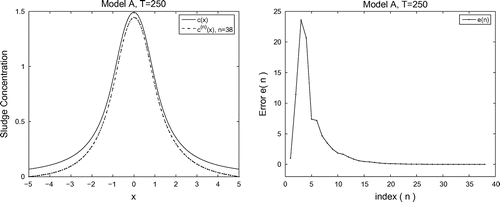
To analyze the convergence of the iteration algorithm (11) and (12) and the accuracy of the difference scheme (15), let us consider the following numerical test example.
Example 1
For the given data ,
,
,
,
, the function
is an exact (analytical) solution of the problem
16
16 where
denotes the final time and simulates the infinity. The source function
is obtained from the analytical solution
and input data
by using symbolic mathematics toolbox in MATLAB. The value of
will be defined below. The length parameter
is chosen large enough to simulate the initial model (1). Here this value is taken to be
. Calculating the integral in (1) over
we found
. Thus the pair
is exact (analytical) solution of the identification problem (9) and (10), corresponding to the Model A.
The iteration scheme (11) and (12) is applied for determination of the approximate numerical solution of this problem. At each
th step of this iteration scheme the linear transport-diffusion problem (11) is solved by the difference scheme (15), and the integral in (12) is calculated by the trapezoidal rule. Results of computational experiments for various grid parameters
are given in Table . The condition
, with
, is used as a stopping criterion in this iteration process. Optimal values of grid parameters are obtained to be
(or
),
, as the values of sup-norm errors
,
given in Table show. Numerical solutions of the identification problem (16), corresponding to these values of grid parameters and to the final time values
and
are very close, as the sixth and seventh columns of the table show. This means that the value
can be taken as optimal value of the final time
in subsequent computational experiments.
For the value , of the stopping parameter, the elapsed CPU time was about
sec. Here and below all computational experiments were done with computers PENTIUM(R) Dual Core processor, E5300, 2.6 GHz. The number of iterations is given in the last column of Table . Note that next decrease of the stopping parameter
does not effect on the numerical values of the coefficient
. Thus in combination with the difference scheme (15), the proposed iteration process has high accuracy, and its convergence is fast enough.
The behavior of the density function for the optimal final time value
and for the intermediate time value
are given in the left and right upper Figure , respectively. The small compact support of the both functions
show that in the case of homogeneous boundary conditions the identification problem (1) can indeed be considered in the finite parabolic domain
, choosing an approximate
. The left below Figure shows exact solution
(solid line )and the approximate solution
(dashed line) of identification problem (16). The errors
are plotted in the right below Figure . The optimal values of iterations were found
as the Figure shows.
Next series of computational experiments is related to an influence of the variable diffusion coefficient to the behavior of the sludge concentration
in the Model A. For this aim, the piecewise linear diffusion coefficient
17
17 its average, i.e. the constant
, and the function
, obtained by ‘smoothing’ the piecewise linear diffusion coefficient
, were assumed to be three different input data in the identification problem (16) (the left Figure ). Other input functions and parameters in the identification problem (16) were taken to be as in Example 1. Numerical values of the sludge concentration functions
corresponding to the variable coefficients
are obtained to be close to the constant diffusion coefficient case. The results of computational experiments are given in the right Figure . The curves plotted in this figure show that an influence arising from the averaging/smoothing of the diffusion coefficient
can be neglected in the range of acceptable scales:
,
.
To find out an influence of the velocity function to the behavior of the sludge concentration
in the Model A, the nonlinear identification problem (1) and (2) is analyzed for different settling velocity functions. For this aim the input data
,
,
,
,
,
,
and
, with the constant diffusion coefficient
, are used in the computational experiments below. The behavior of the sludge concentration
in the settler is studied for the following settling velocity functions:
,
and
(the left Figure ). Note that
, and the constant velocity function
can be treated as a limiting case of the time dependent velocity functions
,
, when
. The computational results show that
iterations are required for the value
of the stopping parameter
. The obtained numerical results are plotted in Figure (b). This figure shows that the mapping
is an antitone one. Specifically,
implies
. This means that the sludge concentration decreases by increasing the settling velocity.
Table 1. Results of computational experiments for the Model A.
4 Computational analysis of the Model B
The Model B can be formulated as the following identification problem: Find pair of functions satisfying the following linear parabolic problem:
18
18 from the nonlocal additional condition
19
19 When the sludge concentration function
is known, then the parabolic problem (18) defines the linear direct problem.
Applying the similar linearization (iteration) scheme, given for Model A above, to the identification problem (18) and (19) we obtain:20
20 where
21
21 is a nonlinear operator, and
22
22 The function
represents an approximate solution of the identification problem (18) and (19). Assuming
, we conclude that the function
solves the linear parabolic problem (4) with the transport term
, where
. Thus the finite-difference scheme (15) and Theorem 1 can be applied to the this model.
Theorem 3
Let be solution of the linearized parabolic problem (20) and (21). Assume that
and conditions of Theorem 1 hold. Then,
23
23
Proof
Applying estimation (7) for the case , we have
Estimating the right hand side integral as in the proof of Theorem 2 we get the required result.
For , estimate (23) has the form:
Requiring
we conclude following result if the conditions of convergence in Theorem 3 hold.
Conclusion 2. Let conditions of Theorem 3 hold. Assume that the arbitrary parameter in
is defined so that the condition
holds. Then the iteration scheme defined by (20) and (21) converges in the norm of the space
.
Table 2. Results of computational experiments for the Model B.
Since the accuracy of the solution to the considered identification problem strictly depends on the accuracy of the numerical solution of the corresponding to the linear problem, one needs first to derive an optimal mesh for numerical solution of linearized problem (20) and (21).
Figure 6. The ‘square wave’ initial density function (the left figure) and the corresponding solution
(the right figure) of the identification problem (17) in the Model B.
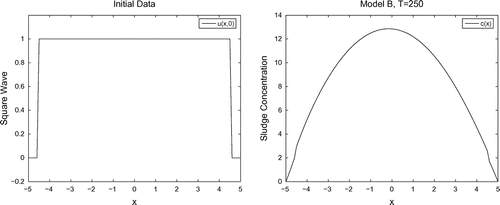
Figure 8. Behavior of the sludge concentration for various values of the maximum settling velocity
and the model parameter
, given in [Citation17], and for different initial data.
![Figure 8. Behavior of the sludge concentration c(x) for various values of the maximum settling velocity ν0>0 and the model parameter α0>0, given in [Citation17], and for different initial data.](/cms/asset/d9b18fc2-90fd-4cd4-9618-5c9f08d1b89f/gipe_a_890609_f0008_b.gif)
Example 2
For the given data ,
,
,
, the function
is an exact (analytical) solution of the problem
24
24 To simulate infinity in the initial model (1), here the length parameter
is again taken to be
in practice. The source function
is obtained from the analytical solution
and input data
by using symbolic mathematics toolbox in MATLAB. Calculating the integral in (21) over
we obtain
. Thus the pair
is exact (analytical) solution of the identification problem (21), corresponding to the Model B.
Results of computational experiments are presented in Table . As in the case of the Model A, the optimal values of grid parameters are obtained to be ,
. Further, the numerical results corresponding to the final time values
and
are obtained to be very close as seen easily from the fifth column of Table . Hence the value
can be taken as optimal value of the final time
for the Model B, also.
Now, we consider identification problem (18) and (19). The behaviour of the density function within the Model B is analyzed for ‘square wave’ form which is initial data
, given in the left Figure . The right Figure illustrates the corresponding solution of the identification problem (18) and (19), i.e. the sludge concentration function
. For the optimal final time value
and for the intermediate time value
in problem (17), the behaviour of the density of sludge concentration function
are presented in left and right Figure , respectively. In the both cases the function
rapidly tends to zero as the time variable
increases. The small compact support of the both functions
show that in the case of homogeneous Dirichlet boundary conditions the identification problem (18) and (19) can indeed be considered in the finite parabolic domain
.
To study an influence of the initial density to the further behavior of the sludge concentration, series of computational experiments are realized for two different input data:
, and
is the ‘square wave’ function given in the left Figure . The left and right Figure illustrates the corresponding sludge concentration functions. The left Figure corresponds to the input data
, and shows the behavior of the sludge concentration
for various values of the maximum settling velocity
and the model parameter
, given in [Citation17]. Bold faced solid line here corresponds to the gravity induced sludge velocity model
25
25 The both figures show that if the relative measurement errors
are of about
, then the behavior of the sludge concentration
is the same as in the gravity induced sludge velocity model. Hence an influence of the initial density
to the further behavior of the sludge concentration is more essential than the influence of the model parameters
and
, as the computational experiments show.
5 Comparative analysis of the models
To compare the behavior of the sludge concentration within the Model A and Model B, first we consider the ‘square wave’ initial density case for both models (with the input data
,
,
,
). The left Figure illustrates results of computational experiments for the cases when
and
in the Model A, and
,
in the Model B (the gravity induced sludge velocity model, given by (22)). Here and below the sludge concentration function
corresponds to the velocity parameter
, in the Model A, and to the pairs
, in the Model B. The right Figure illustrates the behaviour of the sludge concentration computational within the Model B, when
and
, and within the Model A, when
. Comparison of the results presented in both figures show that the behaviour of the sludge concentration function
is almost linear within the Model A, when the velocity function
is a constant. At the same time, this behaviour is nonlinear within the Model B for each input data
. Note that the rapid decay of the function
in the neighborhood of the endpoints
is due to the homogeneous boundary conditions (
).
To analyze the sensitivity of the sludge concentration function with respect to the input data
series of computational experiments were performed for the both considered models. The left and right Figure shows noise free (
,
) and noisy (
,
) numerical solutions corresponding to the Model A and Model B. The noise factors
in the noisy parameters
and
are assumed to be
(left figure) and
(right figure). The noise free input data
in the computational experiments are assumed to be as
in the Model A, and
in the Model B. The relative errors defined to be as
are obtained as follows:
These results show that the noise levels
and
in the measured input data
are acceptable within the considered models.
6 Conclusions
We have discussed two age dependent transport-diffusion settler models. Both model leads to a nonlinear identification problem with additional (nonlocal) integral conditions. We proposed an iteration (linearization) algorithm for solving this identification problem. This iteration scheme leads both models to the basic problem, which mathematical analysis is given in detail. These results are then applied each model to prove convergence of iterations. An effective numerical algorithm for computational simulation of these models is proposed. The algorithm is tested for the both models. Computational simulation permits one to estimate an influence of the model parameters and
the behaviour of the sludge concentration
.
Acknowledgments
The author gratefully thank the anonymous referees for valuable suggestions which improved the manuscript. The author also would like to thank Prof. Dr Alemdar Hasanoglu (Hasanov) for his valuable comments and suggestions leading to a better presentation of this article.
Notes
1 The work has been supported by the Scientific and Technological Research Council of Turkey (TUBITAK) through the research project [grant number 108T332].
References
- David R, Vasel J-L, Vande Wouwer A. Settler dynamic modeling and MATLAB simulation of the activated sludge process. Chem. Eng. J. 2009;146:174–183.
- Ossenbrungen P, McIntire S. Using shock wave theory to predict clarifier performance. In: Yokohama, Kyoto,editors. Proceedings of the 5th IAWPRC Workshop. Japan: Plenum Press; 1990. p. 479–486
- Laikari S. Simulation of the sludge blanket of a vertical clarifier in activated sludge process. Water Sci. Tech. 1989;21:621–629.
- Takacs I, Party G, Nolasco D. A dynamic model of the clarification-thickening process. Water Res. 1991;25:1263–1271.
- Chancelier JP, de Lara MC, Pacard F. Analysis of a conservation PDE with discontinuous flux: a model of settler. SIAM J. Appl. Math. 1994;54:954–995.
- Chancelier JP, de Lara MC, Joannis C, Pacard F. New insights in dynamic modeling of a secondary settler - I. Flux theory and steady state analysis, Water Res. 1997;31:1847–1856.
- Chancelier JP, de Lara MC, Joannis C, Pacard F. New insights in dynamic modeling of a secondary settler - II. Dynamic analysis, Water Res. 1997;31:1857–1866.
- Hasanov A, Mueller J. A numerical method for backward parabolic problems with non-selfadjoint elliptic operator. Appl. Numer. Math. 2001;37:55–78.
- Chancelier JP, de Lara MC, Pacard F. Existence of a solution in an age-dependent transport-diffusion PDE: a model of settler. Math. Models Meth. Appl. Sci. 1995;5:267–278.
- Pektas B. Modeling and computer simulation of the identification problem related to the sludge concentration in a settler. Math. Comput. Model. 2009;49:843–855.
- Lenhart S. Optimal control of a convective-diffusive fluid problem. Math. Models Meth. Appl. Sci. 1995;5:225–237.
- Vesilind AP. Design of prototype thickeners from batch settling tests. Water Sewage Works. 1968;115:302–307.
- Vanderhasselt A, Vanrolleghem PA. Estimation of sludge sedimentation parameters from single bath settling curves. Water Res. 2000;34:395–406.
- Vitasovic Z. Continuous settler operation: a dynamic model. In: Party GG, Chapman D, editors. Dynamic modeling and expert systems in wastewater engineering. Chelsea: Lewis Publishers; 1989. p. 59–81.
- Hasanov A, Pektas B, Kadiroglu U. An analysis of nonlinear ion transport problem including arbitrary valences of oxidized and reduced species. J. Math. Chem. 2010;47:1248–1262.
- Munavalli GR, Kumar MSM. Water quality parameter estimation in a distribution system under dynamic state. Water Res. 2005;39:4287–4298.
- Smolianski A, Shipilova O, Haario H. A fast high-resolution algorithm for linear convection problems: particle transport method. Int. J. Numer. Meth. Eng. 2007;70:655–684.
- Vairaktaris E, Vardoulakis I, Papamichos E, Dougalis V. Subsidence diffusion-convection. II. The inverse problem. Comput. Meth. Appl. Mech. Eng. 2004;193:2761–2770.
- Ladyzhenskaya OA. Boundary value problems in mathematical physics. New York (NY): Springer Verlag; 1985.
- Samarskii AA. The theory of difference schemes. New York (NY): Marcel Dekker; 2001.


